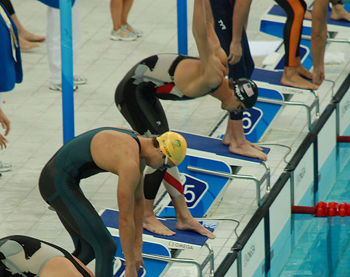
By the skin of their suits

Start of the women's 400 m freestyle at the 2008 European Championships. Image: Miho.
The men's and women's 100 metre freestyle swimming races are set to be two of the most glamorous events of the London 2012 Olympic Games. Much has been made of the swimming events for London 2012 because the previous 2008 Beijing Olympics saw an unprecedented number of new world records, due to the use of controversial swimsuits. Sixty-six Olympic records were broken during the 2008 Games – indeed, in some races the first five finishers beat the old Olympic mark – and 70 world swimming records were broken in total throughout the year 2008.
The controversial swimsuits have now been banned, but the records they set have not been revoked, so the 2012 Olympics are unlikely to see many new records. This does not mean, however, that the events will be any less competitive, and indeed if records are broken, the performances will likely be exceptional.
Pumping iron or beating drag?
Broadly speaking, records in all sports are determined by two factors: the physical and mental performance of the athlete and technological influence. Pure physical performance tends to improve over time as our understanding of the scientific aspects of sport lead to improved training techniques, diets and race tactics. Technological factors, such as a more supportive shoe, aerodynamic bike or faster car can also lead to quicker times. Some sports such as Formula One car racing have an obvious reliance on technology – notwithstanding the incredible physical and mental toughness required to withstand the cockpit of the F1 car. Other sports such as long distance running may have very little to do with technology, with famous examples of Kenyan runners winning major world events bare foot.
Although at first impression swimming seems to rely little on technology, there are many factors outside a swimmer's control that influence their final time. The type of pool has a considerable influence — the first four Olympics Games were not held in pools, but in open water (1896 in the Mediterranean Sea, 1900 in the Seine River, 1904 in an artificial lake). The 1908 Games were held in a 100 metre pool, whilst the 1912 Games were held in Stockholm harbour. The 1924 Olympics were the first to use a 50 metre pool with marked lanes, and the 1936 Games saw the introduction of diving blocks. Before the 1940s male swimmers wore full body suits that were heavy and caused a lot of drag. Pool designs have also changed with pool and lane width modified to eliminate currents, and energy absorbing lane barriers used to stop waves from adjacent lanes. (See below for a chart of world records over the 100 metre freestyle event since 1904.)
There are, broadly speaking, two things you can do to reduce your swimming time:
- Increase your power
- Reduce your drag
- $\rho$ is the mass density of the fluid
- $v$ is the speed of the swimmer relative to the fluid
- $A$ is the swimmer's cross-sectional area, that is the area of your body as it is pushing through the water head on
- $C_D$ is the drag-coefficient, a number which depends on factors such as the exact shape of the swimmer and the hydrodynamic qualities of their skin and what they are wearing.
The exact same working can be used for cross-sectional area — a reduction of 25% will increase your speed by 10%. This is actually the key to the simplest method of reducing drag for most swimmers: improving your technique. Because human lungs are full of air, when we swim our upper body tends to rise and our lower body sinks, increasing cross-sectional area A. The drag force increases and you slow down. Keeping your feet nearer the surface is the easiest method of reducing drag for everyday swimmers.
Drugless doping
At the top end of competitive swimming nearly all swimmers already have very good techniques, so swimsuit technology comes into play. Materials have been developed that increase the swimmer's buoyancy, making it easier to keep their feet near the surface, and reduce the drag coefficient as the material glides through the water more easily than human skin does.

Michael Phelps of the United States (top) and Eamon Sullivan of Australia at the start of the 4x100 relay event at the 2008 Summer Olympics, Beijing. Both are wearing LZR Racer swimsuits. Image: Jmex60.
Full-length high-tech swimsuits were first introduced in 1999 before the 2000 Sydney Olympics, with the Speedo Fastskin suits containing V-shaped ridges, modelled on shark skin, to reduce drag. By 2008, the Speedo LZR Racer swimsuit was the most advanced. It was put through wind tunnel tests by NASA and mathematicians modelled water flow around it using a technique called computational fluid dynamics, which simulates how fluid flows around objects (see this article for more on modelling fluid flow). And this research all happened before real swimmers tested the suits in real pools. In Beijing, 89% of all swimming medals were won by swimmers wearing LZR Racer suits.
One of the ways the LZR Racer suits reduce drag is by having panels of a plastic called polyurethane on parts of the body that produce the highest drag. Other swimsuit manufacturers took note. Instead of being textile based with only patches of polyurethane, suits like the subsequent Arena X-Glide were made entirely of polyurethane. These suits were completely impermeable to water, so swimmers could conceivably complete their race without getting wet between their ankles and neck! Records continued to tumble.
The governing body for swimming, FINA (Fédération Internationale de Natation – International Swimming Federation), took note of the plummeting records and the accusations of "technological doping". In March 2009 it put limits on the suits' thickness and buoyancy, affirming that "FINA wishes to recall the main and core principle that swimming is a sport essentially based on the physical performance of the athlete." They also stipulated that the suits should not cover the neck, shoulders and ankles.
This edict did not actually ban any of the new suits at the 2009 World Aquatics Championships (the "plastic games") — 38 meet records were broken. Subsequently all body-length swimsuits were banned. It was ruled that men's swimsuits may only cover the area from the waist to the knee, and women's from the shoulder to the knee. FINA also ruled that the fabric used must be a textile and not polyurethane. Despite these new rules, the records set by the now banned swimsuits were not revoked and still stand.
And as the term "textile" is not defined, and as scientists are pretty clever folk, the ambiguity of the new rules leaves open a large area for swimsuit development.
Record history
The progression of world records over the 100 metre freestyle event is shown below. Apart from some of the pool changes mentioned earlier, records have continued to drop as we increase our understanding of our physical abilities. Other innovations which have helped reduce times include the introduction of diving blocks in 1936 – previously swimmers had just dived from the wall – and the development of the tumble turn in the 1950s.

It is interesting to note that freestyle as we know it now has not always existed. By definition, in freestyle races you can pretty much swim however you like (with some exceptions), unlike breaststroke, butterfly or backstroke which have defined methods of swimming. During the 1840s, even though they were beaten by native North Americans swimming with a front crawl style, British gentleman swimmers (in an oh so British fashion) swam only breaststroke, considering the front crawl too splashy, barbaric and un-European. In the late 1800s, the quickest (British) freestyle was the Trudgen style, named after John Arthur Trudgen, whose stroke was a combination of side stroke and front crawl. The Australian Dick Cavill modified this style to something similar to what is seen today with his Australian crawl and set a new world record for 100 yards in 1902.
The figure below shows a close-up of times from the early 1980s. You can see the decline around 1999 when the first fast-suits came in, then the sharp decline in 2008. It is difficult to predict when the next dots on the curves will occur.

At the time of writing, Australians are the favourites for both the men's and women's 100 metre freestyle events, with James Magnussen and Matt Targett having recorded the quickest men's 100 metre times in 2012, and Melanie Schlanger the quickest women's time. The UK's Francesca Halsall is 5th so far this year in the women's event, however Simon Burnett in 39th would be doing well to make it past the heats in the men's.
About the author

Marc West is a freelance science writer and former Assistant Editor of Plus who currently works in operations analysis in Sydney.
He is one of those stupid people that like to compete in open water swims, battling people kicking him in the head, waves smashing him and sharks trying to eat him. He does it all for the bacon roll at the end. He loves to write about science and sport and has been published in a variety of magazines and newspapers. You can read more of his writing on his personal blog.
Comments
Anonymous
Although i generally agree with what you are saying, the remark that the steep drop of the WR for men in 2000 was because of the suits is a bit misleading.
Pieter vd Hoogenband was only wearing 'legs', not a full body suit (like Thorpe for instance).
Anonymous
I thought James Robert has the second fastest time in the world with 47.63 and it's not Matt Targett.
Anonymous
Found this article fascinating. As an open water swimmer I knew bits of it. The difference the suits made is astonishing. I ordered one a few months ago and even though I ordered the right size when I tried to get it in it I couldn't. No give, no chance! As for Marc, I completely get the bacon roll thing and well....why wouldn't you?
Liz